May 13, 2013
by Carole Zangari -

We’re thrilled to continue our Fresh Look series in celebration of Better Hearing and Speech Month (#BHSM). In this post, Dr. Melanie Fried Oken, from the Oregon Health and Science University, talks about some AAC strategies for people with dementia. I was captivated by her 2012 presentation on this topic at ISAAC 2012, and knew it was important to be able to share some of you work with you. We have much to offer these individuals with dementia, and Melanie’s post and linked resources are a great way to get started. ::::::::::::::::::::::::::::::::::::::::::::::::: Hey, what about us AAC providers who work with adults? We love reading PrAACtical AAC and can often adjust the tips, equipment recommendations, and strategies to meet our population needs. So when Carole gave me an opportunity to blog about AAC for adults with dementia, I grabbed the chance. I’d like to share with you some facts about... [Read More...]
Filed under: PrAACtical Thinking
Tagged With: acquired disorder, adult, dementia, Fresh Look, Melanie Fried-Oken, visual supports
May 10, 2013
by Robin Parker -
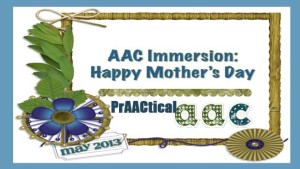
We were just having some in-depth conversations about AAC and making a difference. AAC intervention needs to be part of more than speech-language therapy. It needs to be a way of life, a communication and language interaction style, and fully immersed into all interactions. There are some Mom’s who make this happen. We have written about some of them in Getting From Here to There . But there are more (many more) and for awhile now some have been blogging about their AAC & visual language adventures. Here are just a 5 awesome posts from moms who share AAC rationales and meaningful AAC & language experiences. Learn from the best. Beach Trip (And AAC on the Road) by Dana Nieder– Uncommon Sense Halloween & AAC by Deanne Shoyer – Small But Kinda Mighty Her Eyes Shows She Knows by Catriona– Living With Rett Syndrome An Open Letter to the Parent of a Child with Speech... [Read More...]
Filed under: PrAACtical Thinking
Tagged With: meaningful language experiences, Moms
May 9, 2013
by Carole Zangari -
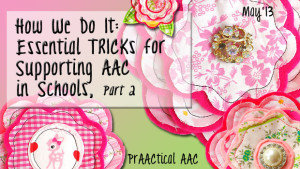
Today we welcome back 3 SLPs from the Orange County Public School (OCPS) AT team, Cathy George, Marcia Sterner, and Marcia Piersall. They are part of a very active and competent AT Team that supports over 700 students with dedicated AAC devices. It is no surprise that they’ve come up with a list of 5 essential TRICKs that they count on to help them support these students and their educational teams. You can read about the first 2 TRICKS, Try It and Resources, here and download some of their terrific resources. Today, we learn about the rest of their TRICKs: Information, Can’t Live Without It, and Kick It Up A Notch. Give Me Five: Essential TRICKS, Part 2 INFORMATION about the student Student interests What systems previously tried What tasks s/he is struggling with Trial data sheet– Communicative competence organizer CAN’T LIVE WITHOUT IT: In addition to AAC devices, these... [Read More...]
Filed under: PrAACtical Thinking
Tagged With: aided language input, Boardmakershare, Cathy George, ELSB, goals, How I Do It, Marcia Piersall, Marcia Sterner, News2you, PCI Reading, schools, Story Grammar Marker, Unique Learning
May 8, 2013
by Robin Parker -
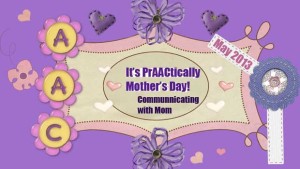
It’s PrAACtically Mother’s Day and we are thinking about gifts and activities that promote communication, language, & literacy. Here are 5 activities that are fun and interesting to plan for and do interactively. In the end, there will also be a tangible and/or intangible gift for mom. Enjoy and please share any additional activities that you have done or seen that you think are great. Visual Supports to Support Conversations with Moms-Thanks so much to Joel Shaul at Autism Teaching Strategies for creating this great visual support that helps support meaningful conversations with mom. Saying I Love You On Mother’s Day– Ideas for teaching communication of “I Love You” for beginning communicator. Mother’s Day Word List– Ideas for using this Mother’s Day Word Bank to create a poem, story, or more.. Words, words, and more words for conversation about mom. Your Special Chef– Use this picture recipe and lesson plan... [Read More...]
Filed under: PrAACtical Thinking
Tagged With: communication, language activities, Mother's Day
May 7, 2013
by Carole Zangari -
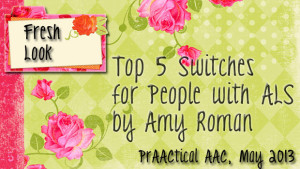
We continue our celebration of Better Hearing and Speech Month (#BHSM) with our Fresh Look series. In this post, we are delighted to share the insights of SLP Amy Roman, whose expertise in AAC supports for people with ALS is well-known. During the past 13 years, Amy has been a member of the multidisciplinary care team at San Francisco’s Forbes Norris ALS Research and Treatment Center. The AAC Program she developed at the Norris Center was awarded Program of the Year by the California Speech and Hearing Association in 2010. Through her private practice, she also provides AAC direct services and phone/skype consultations to individuals, caregivers and therapists. In addition, Amy is the Director of the Golden West ALS Association’s AAC Lending Library. She is also the author of AlphaCore© communication software available on DynaVox speech generating devices. Amy has presents workshops and at conferences on clinical and research topics in AAC.... [Read More...]
Filed under: PrAACtical Thinking
Tagged With: access, alerting system, ALS, Amy Roman, BHSM, call chime, Fresh Look, laser pointer, pALS, switch, switches
May 6, 2013
by Carole Zangari -
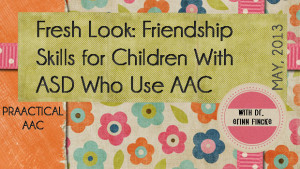
As we’ve said before on this blog, SLPs have great potential to make a difference in the social experiences of people who use AAC by supporting the development of friendships. ASHA’s Better Speech and Hearing Month (#BHSM) gives us a great opportunity to spread awareness that this is an area in which SLPs can make a tremendous difference. We’re so excited to share this Fresh Look post by Dr. Erinn Finke, Assistant Professor of Communication Sciences and Disorders at Penn State University. I was recently lucky enough to find myself in conversation with Pat Mirenda, a top researcher in the field of AAC and Autism Spectrum Disorders (ASD). In trying to decide what we really “know” about effective AAC strategies for children with ASD, we decided that while there is a lot of research regarding how to use AAC to teach children with ASD to request things, there really is not... [Read More...]
Filed under: PrAACtical Thinking
Tagged With: ASD, Erinn Finke, Fresh Look, Friends, friendship, social skills
May 3, 2013
by Robin Parker -

PrAACtical Thinking Happy April: Celebrate Autism Acceptance Month and National Poetry Writing Month Happy World Autism Day! 5 Ways to Get More Popular AAC Style 133 Free or Lite Versions of AAC Apps & App Selection Resources 5 Things To Do If You Are Not Confident Teaching Core Vocabulary 31 Posts You May Have Missed in March Communication Circles:With A Little Help From My Friends Core Vocabulary: Making Sense of Symbols AAC & RTI 5 Reasons for Using Pre-Stroed Messages in AAC Systems Speak To Me With Your Eyes My Love Keep Learning About Core Words: 8 More Things to do for Autism Acceptance Month A PrAACtical Look: AAC at the Baldwin Wallace Speech Center PrAACtical Goals That Matter 5 Ways to Use Powerpoint in AAC Intervention Strategy of The Month Teaching Core Vocabulary The First 12: Getting Started with Core Words More on Teaching Core Vocabulary More on Core... [Read More...]
Filed under: PrAACtical Thinking
Tagged With: autism acceptance month, Core Word Vocabulary
May 2, 2013
by Carole Zangari -
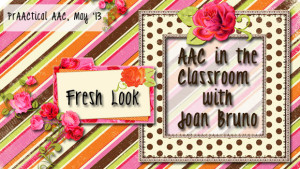
We’re off to a great start for Better Hearing and Speech Month! Today’s Fresh Look post comes from one of the most experienced AAC SLPs in the United States. Joan Bruno, Ph.D., CCC-SLP has over 30 years experience working in the field of AAC. She is currently maintains a private practice consulting to schools and private agencies and is the Augmentative Communication Specialist at the TECHConnection in Shrewsbury, NJ. Joan has published and presented nationally and internationally on a variety of topics related to AAC assessment and intervention. Joan is the 2011-2013 President of the New Jersey Speech and Hearing Association, and a Past-President of the United States Society for Augmentative and Alternative Communication. Since 1992, she has directed Camp Chatterbox, a therapy camp for children using AAC devices. Joan is the author of the Gateway to Language and Learning© page set and the Test of Aided-Communication Symbol Performance© (TASP). In... [Read More...]
Filed under: PrAACtical Thinking
Tagged With: core vocabulary, curriculum, Fresh Look, general education, inclusion, Joan Bruno, Language Arts, schools, word prediction
May 1, 2013
by Carole Zangari -
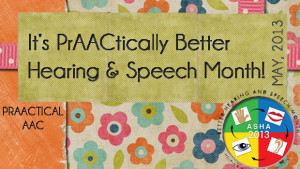
We’re celebrating ASHA’s Better Speech and Hearing Month with a series of posts for SLPs who are working with people who have significant communication difficulties and aren’t currently using AAC strategies. In these posts, we hope to give clinicians a fresh look and some prAACtical ideas about using AAC with a variety of clinical populations. We’ve invited well-respected authors, researchers, and clinicians to contribute to this series. We’re proud to kick-off a new series called Fresh Look with posts on using AAC with children and adults. Watch for posts on on a variety of topics, including: Using AAC to support people with dementia by Dr. Melanie Fried-Oken AAC in General Education with Dr. Joan Bruno Supporting the friendships of children with ASD by Dr. Erinn Fincke Providing initial AAC supports to people with ALS by Lisa Bardach Language therapy with children who use AAC by Drs. Cathy Binger and Jennifer... [Read More...]
Filed under: PrAACtical Thinking
Tagged With: Better Hearing and Speech Month, BHSM
April 30, 2013
by Carole Zangari -
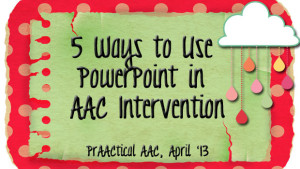
We know that there are lots of PowerPoint haters out there, but we’re not among them. While we have certainly suffered through a presentation or two in which it was used poorly, we’ve also been inspired by those who use it well. It has lots of uses beyond teaching and presentation. Here are some ideas for using it to enhance your AAC intervention. 1. Personal Dictionary: Create a dictionary with slides for the new words the individual is learning. You can record the pronunciation of the word, provide the definitions, give examples, illustrate with images, and link to external sites. 2. Switch-accessible Books: These are fun to make and positively addictive once you get started! In the AAC Literacy Camp we did a few years ago, we made lots of little books like the one shown here and printed hard copies for the kids to take home. Reading online is... [Read More...]
Filed under: PrAACtical Thinking
Tagged With: accessible books, intervention, PowerPoint, reading, resources, therapy, vocabulary, writing









